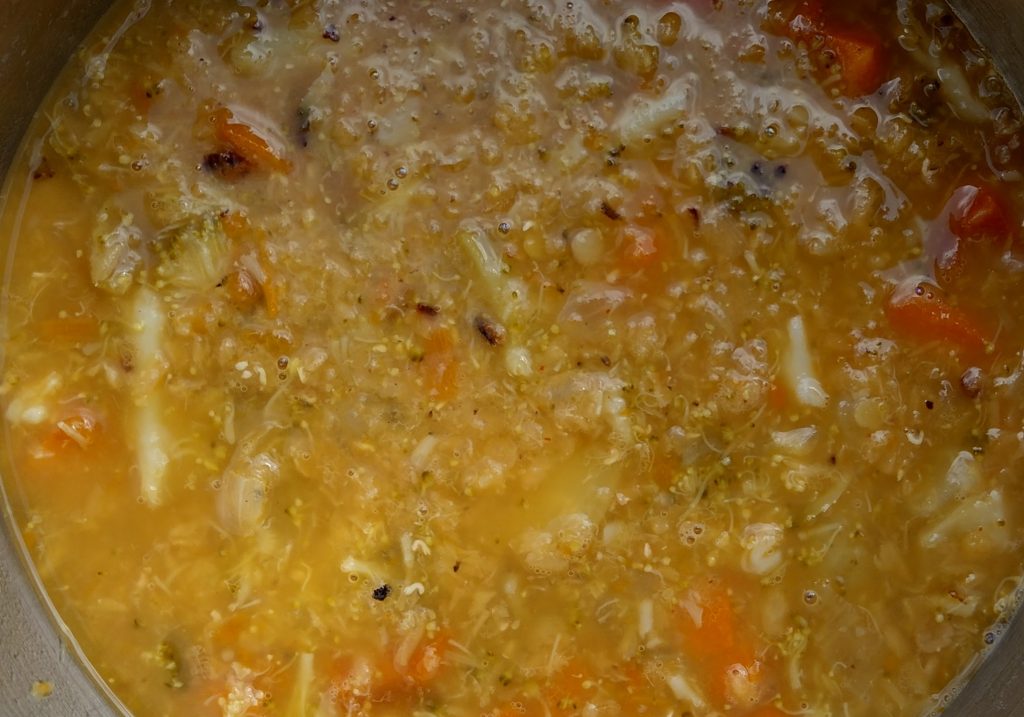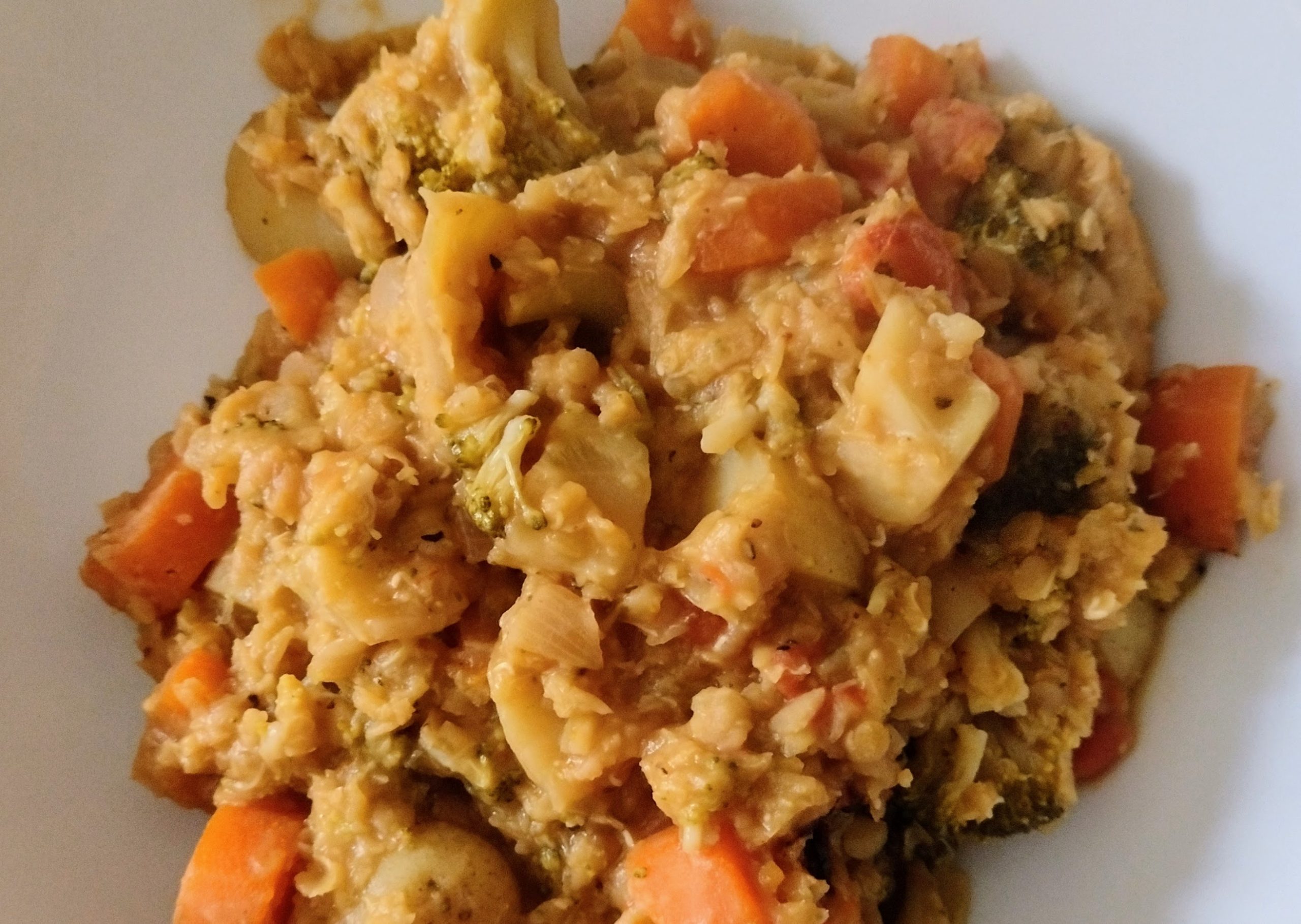Long before exiting the arrival hall; before we’ve landed and, perhaps, before we’ve even taken off, my mind is on one thing only. Not, this time (as it’s mid-summer), how cold I’m going to be on the train, but on my one overwhelming, all-encompassing desire: to attack, in the manner of a starving wolf, all the foods I’ve been craving. To satiate myself with the nutrients I feel I’ve been missing, while travelling on a strict budget in places which are not traditionally vegan/vegetarian-friendly.
Reunions with friends and family are also a pleasurable anticipation and my first stop is my cousin’s, just a couple of hours on the train from Heathrow and seventeen since leaving my KLIA (Kuala Lumpur airport) hotel. Here, despite the fact it’s internally around 3am, I can scratch both itches at once because, as I hoped, Margaret has made her special, wonderful, chunky vegetable soup. I can always eat a bowl of this whether I’m hungry or not, and the modest-sized panful doesn’t last as long as my greed. The next day I make another one, or my own version of it, crammed with everything good. I can feel every cell swelling and coming back to life with the injection of lentils, broccoli, carrots and whatever else I’ve found in the fridge.
I’ve eaten some fabulous food on my journey, particularly in Asia: from the crispy samosas of Goa and the favourite dhal wade in Sri Lanka to the thick, sticky, dark tempeh dishes made with sweet soy sauce (kecap manis) and lemongrass, and aubergines in a peanut-coconut sauce, specialities of Indonesia. Possibly the best Indian food I’ve ever tasted is to be found, conversely, in Malaysia, where their take on a biriyani is truly on another level, though gourmets may swoon at the divine oiliness and intensity of flavour, requiring little accompaniment. Paired with a ubiquitous iced tea (simply a weak, black tea with or, usually, without lemon, over a pile of ice, served with half a kilo of sugar, in a plastic beaker), it’s one of the experiences I’m always guaranteed to miss the most.
As I get ready to return to the UK, though, ask me which one food item I’m most desperate for, and I’m likely to say a potato. I rarely find enough when travelling (Asia, of course, being predominantly rice-based), and I would happily live on them. In fact, I once did: for a period of several months, as a toddler, I point-blank refused to eat anything else. I was a strange child.
Unless I’m in Europe, I’m also perplexed at how one can live without olive oil. In Southeast Asia, I don’t get enough beans, and in Oceania there’s not a huge variety of vegetables of any kind, although there are various intriguing subspecies of taro (yam). It’s not a potato, however, and its leaves are not spinach, no matter what they tell you, or however delicious pulsami may be. It’s all just so…limited.
I make, then, the largest pot of vegetable stew/soup that I possibly can, and eat it day and night until I feel normal. In the unlikely event I tire of it while there’s any left, I’ll portion it up and put it in the freezer, though the very best part is the lightly browned, crusty bit stuck to the bottom of the pan. My ‘recipe’, such as it is, differs from Margaret’s in that a couple of ingredients are paramount, whereas hers isn’t fussy (yet she always succeeds in achieving the same flavour). She adds dried herbs with similar abandon, and to great effect, while they’re something I almost never use.
Given below are loose instructions for my version but if you have any fresh thyme growing in the garden – or in someone else’s – you may want to toss a sprig or two in; or what about a couple of fresh bay leaves? Any herbs should be used in strict moderation, though, to avoid overpowering the wholesome flavours of the vegetables.
A sprinkle of uncooked, chopped, flat-leaf parsley works well for serving and adds iron, calcium and magnesium, as well as the vitamins you would expect from something so fresh and green. If you’re not keen, I sometimes cook it in, instead.
Hearty Leftover Vegetable and Lentil Soup-Stew
Ingredients:
1 medium-large onion, chopped (imperative)
6-10 baby potatoes, skin on, cubed (imperative, although bigger, flourier potatoes also work)
2 large/4 or 5 small carrots, scrubbed and sliced or cubed (imperative)
1 medium head broccoli, in florets, tender part of stem chopped (imperative, although if you don’t have broccoli you could substitute finely-shredded kale or spring greens)
1 pepper, preferably red or orange, in chunks (can be left out, or substituted by a few cherry tomatoes)
2 or 3 sticks of celery, de-stringed and sliced (can be left out, or add some small chunks of celeriac, or parsnips, instead)
1 mug of red lentils, rinsed thoroughly and drained (I love red lentils but the soup would also work – a bit differently – with puy or ‘continental’ lentils) (imperative)
1 vegetable stock cube – check it’s dairy-free!
1 very well-loaded teaspoon of Marmite
Lots of freshly-ground black pepper
Salt to taste
Optional: a squeeze of tomato purée.
If available, you could add any (or all) of the following:
Swede or turnip, peeled, in small dice
Sweet potato, peeled, in large chunks
A green pepper, in chunks
Brussels sprouts, trimmed and halved
Parsnips, peeled and diced
Green beans, topped and tailed
Note: If adding a lot more vegetables, you’ll need to add an extra onion and increase the amount of stock and Marmite accordingly.
Method:
Start the onion off in a little bit of olive oil, then before it starts to brown, add all the other vegetables, beginning with the root veg, stirring with each addition, keeping it moving. (On a diet? You can leave out the first step and just put everything in the pan at once, without using any oil).
Add enough water to just cover the vegetables and bring to the boil. Stir.
Tip in the drained lentils, crumbled stock cube, Marmite, and one squeeze of tomato purée, if using. Stir well and make sure the lentils are covered with the water.
Bring back to the boil, watching the lentils don’t foam over. If foam rises, it should be removed with a spoon, after which it should settle down. Stir again and reduce to a low simmer, with a lid covering the pan but leaving it slightly askew, with a small gap to allow steam or foam to escape.
Check periodically that the lentils have not soaked up all the liquid. If necessary, add a little more water, but any more than a splash will reduce the flavour. Stir in a good few twists of black pepper while it’s simmering.
It’s ready when the hardest vegetables are soft (e.g. the potatoes, carrots and turnips) and the lentils are fully mushy.
Add salt if needed, but often the stock and Marmite will be enough.
Sprinkle over fresh parsley if you have any, and enjoy with warm, crusty bread, pitta bread or even herbed, garlic bread.
Hot tips:
If you have a half-used can of baked beans in the fridge, you can tip these in as well. Despite the doubts and wrinkled noses of my previous workmates, it works.

Like it salty? Add a splash of light soy sauce. A bit fusion, perhaps, but I make an exception for soy sauce – it goes with everything!
It goes without saying, of course, that scant liquid makes it more of a stew. Add more for a soup.
Once I’ve eaten my own bodyweight in my favourite foods – salt ‘n’ vinegar crisps are another craving – I’ll write more about my travels. I can’t do it on an empty stomach!
